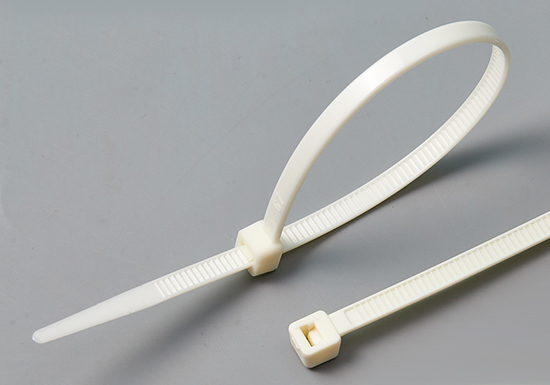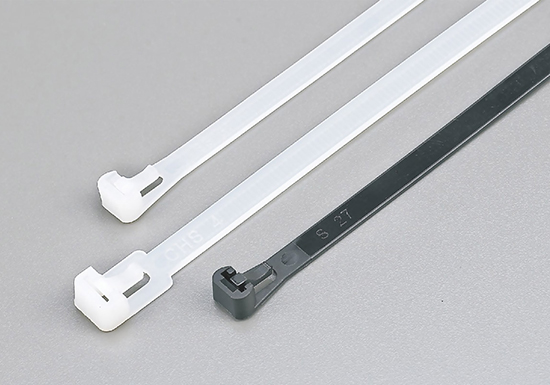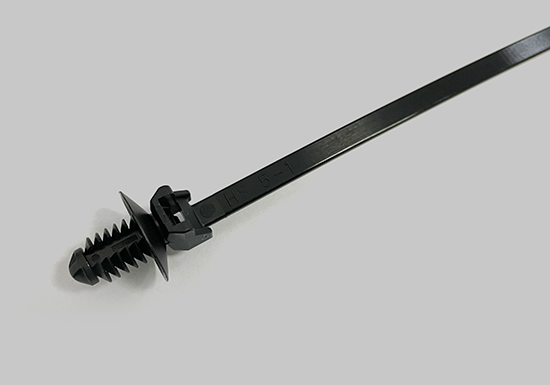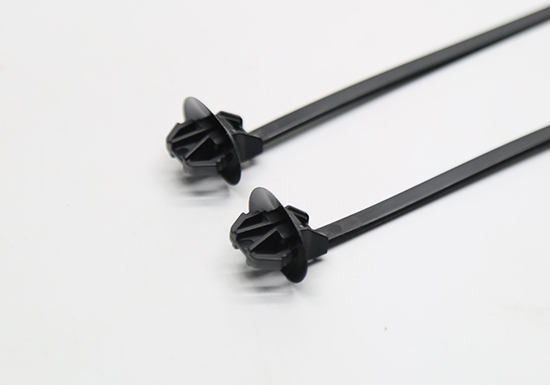What are the requirements in the injection molding process of PA66 nylon cable ties?
2025-08-05 15:37:04 View:284
PA66 nylon cable ties, as widely used fasteners in the industrial field, their injection molding process directly determines the mechanical strength, weather resistance and dimensional stability of the product.
To achieve high-quality production, it is necessary to conduct full-process refined control from material pretreatment, mold design, process parameter control to post-treatment. The following is a systematic analysis of the key process points: I. Material Pretreatment and Drying Process
I. Material Pretreatment and Drying Process
PA66 resin has strong hygroscopicity. A moisture content exceeding 0.2% can lead to silver streaks, bubbles, and even molecular chain degradation on the surface of injection molded parts.
A three-stage drying scheme should be adopted: preheating at 80°C for 2 hours → constant temperature drying at 105°C for 4-6 hours → holding at 80°C for standby. The dried material should be used within 2 hours.
It is recommended to use a dehumidifying dryer in conjunction with a dew point detector to ensure that the air dew point is ≤ -40°C.
For colored cable ties, color masterbatches should be dried simultaneously with the base material, with a ratio controlled at 3%-5% to avoid color differences.
II. Core Elements of Mold Design
1. Gate System: A combination of hot runner and cold runner is adopted. The main gate diameter should be ≥ 4mm.
The runner adopts a trapezoidal cross-section (top base 5mm, bottom base 8mm, height 6mm) to ensure that the temperature difference of the melt flow front is < 5℃.
For the tooth shape structure of the cable tie, 8-12 overflow wells should be set in each cavity, with a depth of 0.03-0.05mm.
2. Cooling System: A layered spiral waterway is used, with a distance of 12-15mm from the cavity surface. The water temperature is controlled at 20±2℃.
For areas with sudden thickness changes (such as the lock part), additional cooling copper tubes should be added separately.
3. Ejection Mechanism: 16-24 ejector pins with a diameter of Φ2mm are configured. The ejection stroke should exceed 20% of the total length of the cable tie.
The ejection speed is controlled in segments (initial stage 0.3m/s, final stage 0.1m/s). III. Optimization of Injection Molding Process Parameters
III. Optimization of Injection Molding Process Parameters
1. Temperature Control: The five temperature zones of the barrel are set at 240℃ (feed zone) → 255℃ → 265℃ → 270℃ (metering zone) → 260℃ (nozzle). The mold temperature is 80-90℃, with a temperature fluctuation of less than ±1.5℃.
2. Pressure Parameters: Injection pressure is controlled in three stages (80MPa → 110MPa → 60MPa), and the holding pressure is 60% of the maximum injection pressure. The holding time is calculated based on 0.8 seconds per 1mm of wall thickness. Back pressure is maintained at 5-8MPa.
3. Cycle Control: Injection time is 3-5 seconds, and cooling time is calculated based on the maximum wall thickness squared multiplied by 1.5 (e.g., 6 seconds for a 2mm wall thickness). The mold opening and closing time does not exceed 3 seconds.
IV. Key Process Control Points
1. Molecular Orientation Control: By adjusting the injection speed (30-50mm/s) and mold temperature, maintain the melt shear rate within the range of 5000-8000s⁻¹ to prevent excessive orientation from causing a decrease in transverse strength.
2. Crystallinity Management: Utilize a gradient cooling process. Immediately after injection molding, transfer to a 60°C water bath for 20 minutes to stabilize the crystallinity at 35%-40%, which can increase tensile strength by more than 15%.
3. Dimensional Stability Control: For high-precision cable ties with a tolerance requirement of ±0.05mm, conduct mold flow analysis to optimize the gate location and use a PID closed-loop control oil temperature system (with fluctuations within ±0.5°C).
V. Post-treatment and Quality Inspection
1. Moisture conditioning: Place the products in an environment of 90℃ and 65% relative humidity for 4 hours to balance the moisture content to 2.5%-3%, which can eliminate internal stress and enhance impact strength.
2. Full inspection items: Include pitch accuracy (measured by projector), tensile strength (≥800N/10mm), flame retardancy (UL94 V2 or above), and low-temperature brittleness (no fracture after bending 180° at -40℃ for 2 hours).
3. Batch testing: For every 200kg of material, test the melt index (18-22g/10min at 275℃/5kg) and ash content (≤0.1%).
VI. Common Defect Solutions
1. Flash problem: Check the mold clamping force (should be > 3.5t/cm²), reduce the injection speed by 10%-15%, and verify the sealing performance of the screw reverse stop ring.
2. Shrinkage mark defect: Increase the holding pressure by 15%-20%, extend the holding time by 30%, and add cooling ribs on the back of the product if necessary.
3. Surface flow mark: Raise the melt temperature by 5-8℃, and mirror polish the mold surface (Ra ≤ 0.05μm). Through the above systematic control, the injection molding qualification rate of PA66 nylon cable ties can be stably maintained at over 99.2%.
Through the above systematic control, the injection molding qualification rate of PA66 nylon cable ties can be stably maintained at over 99.2%.
It is worth noting that the differences in nucleating agent formulas of resins from different manufacturers can cause the optimal process window to shift.
It is recommended to conduct DSC differential scanning calorimetry analysis and re-determine the crystallization temperature range whenever the raw material batch is changed.
With the application of new processes such as microcellular injection molding, the future production of cable ties will move towards lightweighting (weight reduction of 15% - 20%) and functionalization (conductive, anti-static), which poses higher requirements for process control.
To achieve high-quality production, it is necessary to conduct full-process refined control from material pretreatment, mold design, process parameter control to post-treatment. The following is a systematic analysis of the key process points:

PA66 resin has strong hygroscopicity. A moisture content exceeding 0.2% can lead to silver streaks, bubbles, and even molecular chain degradation on the surface of injection molded parts.
A three-stage drying scheme should be adopted: preheating at 80°C for 2 hours → constant temperature drying at 105°C for 4-6 hours → holding at 80°C for standby. The dried material should be used within 2 hours.
It is recommended to use a dehumidifying dryer in conjunction with a dew point detector to ensure that the air dew point is ≤ -40°C.
For colored cable ties, color masterbatches should be dried simultaneously with the base material, with a ratio controlled at 3%-5% to avoid color differences.
II. Core Elements of Mold Design
1. Gate System: A combination of hot runner and cold runner is adopted. The main gate diameter should be ≥ 4mm.
The runner adopts a trapezoidal cross-section (top base 5mm, bottom base 8mm, height 6mm) to ensure that the temperature difference of the melt flow front is < 5℃.
For the tooth shape structure of the cable tie, 8-12 overflow wells should be set in each cavity, with a depth of 0.03-0.05mm.
2. Cooling System: A layered spiral waterway is used, with a distance of 12-15mm from the cavity surface. The water temperature is controlled at 20±2℃.
For areas with sudden thickness changes (such as the lock part), additional cooling copper tubes should be added separately.
3. Ejection Mechanism: 16-24 ejector pins with a diameter of Φ2mm are configured. The ejection stroke should exceed 20% of the total length of the cable tie.
The ejection speed is controlled in segments (initial stage 0.3m/s, final stage 0.1m/s).

1. Temperature Control: The five temperature zones of the barrel are set at 240℃ (feed zone) → 255℃ → 265℃ → 270℃ (metering zone) → 260℃ (nozzle). The mold temperature is 80-90℃, with a temperature fluctuation of less than ±1.5℃.
2. Pressure Parameters: Injection pressure is controlled in three stages (80MPa → 110MPa → 60MPa), and the holding pressure is 60% of the maximum injection pressure. The holding time is calculated based on 0.8 seconds per 1mm of wall thickness. Back pressure is maintained at 5-8MPa.
3. Cycle Control: Injection time is 3-5 seconds, and cooling time is calculated based on the maximum wall thickness squared multiplied by 1.5 (e.g., 6 seconds for a 2mm wall thickness). The mold opening and closing time does not exceed 3 seconds.
IV. Key Process Control Points
1. Molecular Orientation Control: By adjusting the injection speed (30-50mm/s) and mold temperature, maintain the melt shear rate within the range of 5000-8000s⁻¹ to prevent excessive orientation from causing a decrease in transverse strength.
2. Crystallinity Management: Utilize a gradient cooling process. Immediately after injection molding, transfer to a 60°C water bath for 20 minutes to stabilize the crystallinity at 35%-40%, which can increase tensile strength by more than 15%.
3. Dimensional Stability Control: For high-precision cable ties with a tolerance requirement of ±0.05mm, conduct mold flow analysis to optimize the gate location and use a PID closed-loop control oil temperature system (with fluctuations within ±0.5°C).
V. Post-treatment and Quality Inspection
1. Moisture conditioning: Place the products in an environment of 90℃ and 65% relative humidity for 4 hours to balance the moisture content to 2.5%-3%, which can eliminate internal stress and enhance impact strength.
2. Full inspection items: Include pitch accuracy (measured by projector), tensile strength (≥800N/10mm), flame retardancy (UL94 V2 or above), and low-temperature brittleness (no fracture after bending 180° at -40℃ for 2 hours).
3. Batch testing: For every 200kg of material, test the melt index (18-22g/10min at 275℃/5kg) and ash content (≤0.1%).
VI. Common Defect Solutions
1. Flash problem: Check the mold clamping force (should be > 3.5t/cm²), reduce the injection speed by 10%-15%, and verify the sealing performance of the screw reverse stop ring.
2. Shrinkage mark defect: Increase the holding pressure by 15%-20%, extend the holding time by 30%, and add cooling ribs on the back of the product if necessary.
3. Surface flow mark: Raise the melt temperature by 5-8℃, and mirror polish the mold surface (Ra ≤ 0.05μm).

It is worth noting that the differences in nucleating agent formulas of resins from different manufacturers can cause the optimal process window to shift.
It is recommended to conduct DSC differential scanning calorimetry analysis and re-determine the crystallization temperature range whenever the raw material batch is changed.
With the application of new processes such as microcellular injection molding, the future production of cable ties will move towards lightweighting (weight reduction of 15% - 20%) and functionalization (conductive, anti-static), which poses higher requirements for process control.
Next:





